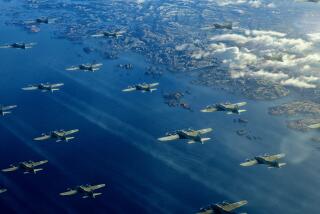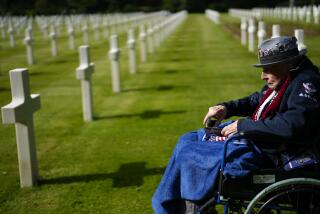For Doolittle’s Men, It’s Party Time Again : Airmen who took part in bombing raid on Tokyo converge on Columbia, S.C., for annual bash.
COLUMBIA, S.C. — Flying ace Jimmy Doolittle promised to throw “one hell of a party” if any of his men lived through a daring air raid on Tokyo, just months after the United States entered World War II.
When the crews of 15 B-25 bombers gathered on the deck of the Hornet on April 18, 1942, the odds were strong that many of them would not survive the mission. But 73 of the 80 fliers did, and Lt. Col. Doolittle kept his promise in 1946.
It must have been some kind of party, because the Raiders have partied every year but one since.
They’ve seen more U.S. cities than a bunch of Shriners. From Pensacola, Fla., to Columbus, Ohio, to Los Angeles to Tacoma, Wash., Doolittle’s intrepid Raiders have honored one another and been honored by others, usually at the others’ expense.
“The cities come to us,” said Brig. Gen. Richard A. Knobloch, who was a co-pilot on crew 13 and is chairman of the Doolittle Tokyo Raiders Assn. Inc. “We’ve never looked.”
For their 50th anniversary this week, the Raiders have come here for a three-day celebration. The $115,000 cost, which includes air fare for 36 of the 40 surviving Raiders who will attend, is being paid for by the city and several local businesses.
Says Mayor Bob Coble: “We thought that this would be a good attraction. It would showcase Columbia as a New South city and honor the Raiders. The story of the Raiders is a fabulous story to tell, a human story of heroism.”
Doolittle, now 95 and unable to make the trip from his Monterey home, will miss quite a bash.
The party committee here drummed up a new play, a state dinner, a ball, a parade and a museum exhibit. Several B-25s will be flown over the local airport, which in 1942 was the Columbia Army Air Base where Doolittle got his volunteers.
Doolittle’s plan was to fly heavy Army bombers from the deck of an aircraft carrier 400 miles off the coast of Japan, drop bombs on military installations around Tokyo and land in China. But 700 miles from land, a Japanese vessel was spotted, so the mission was launched early.
Recalls Maj. Gen. David Jones, now retired, “About two hours after takeoff, my gunner--an 18-year-old kid--called up and said, ‘Sir, we don’t have enough gas,’ and I said, ‘That’s right.’ Click.”
About midday, all 16 planes hit their marks and continued on, the idea being to get as far away as possible. Nine hours later, when they ran out of fuel, 15 were over China and one over Russia.
Knobloch as co-pilot was the second to the last in his crew to bail out.
“None of us had ever jumped from a plane,” Knobloch said. “We didn’t know where we were and couldn’t see what we were jumping into. We pushed out the escape hatch and looked at that black hole, and the wind whistling around. It didn’t last very long, but all I was thinking was I was hungry and hoping I’d find a hamburger stand to get myself a hamburger and a milkshake.”
Knobloch, who lives in Austin, Tex., said the Raiders tell such stories each time they gather.
“The stories seem to get better every year,” he said, chuckling. “I’m not saying anybody lies, but there were 80 people on the raid and there were 80 stories.”
They also drink a toast to their departed comrades, using silver goblets given them by the city of Colorado Springs and stored during the year at the U.S. Air Force Academy. Each goblet has a Raider’s name engraved on it, and the ones belonging to the Raiders who have died are turned upside down.
The Raiders’ memorial at the Air Force Museum in Dayton, Ohio, tells the story of the mission, which inflicted little physical damage on Japan but provided a needed psychological boost to Americans crestfallen by the attack on Pearl Harbor. It also demonstrated to the Japanese that they were not invincible. The adventure became a 1944 film, “Thirty Seconds Over Tokyo,” starring Spencer Tracy as Doolittle.
“We’re all getting to an age now where we’re dropping off,” said Adam Williams, who was Knobloch’s gunner. “We’re so close-knit because we are a bunch of guys who got together and did something that everyone said couldn’t be done.”
More to Read
Sign up for Essential California
The most important California stories and recommendations in your inbox every morning.
You may occasionally receive promotional content from the Los Angeles Times.










